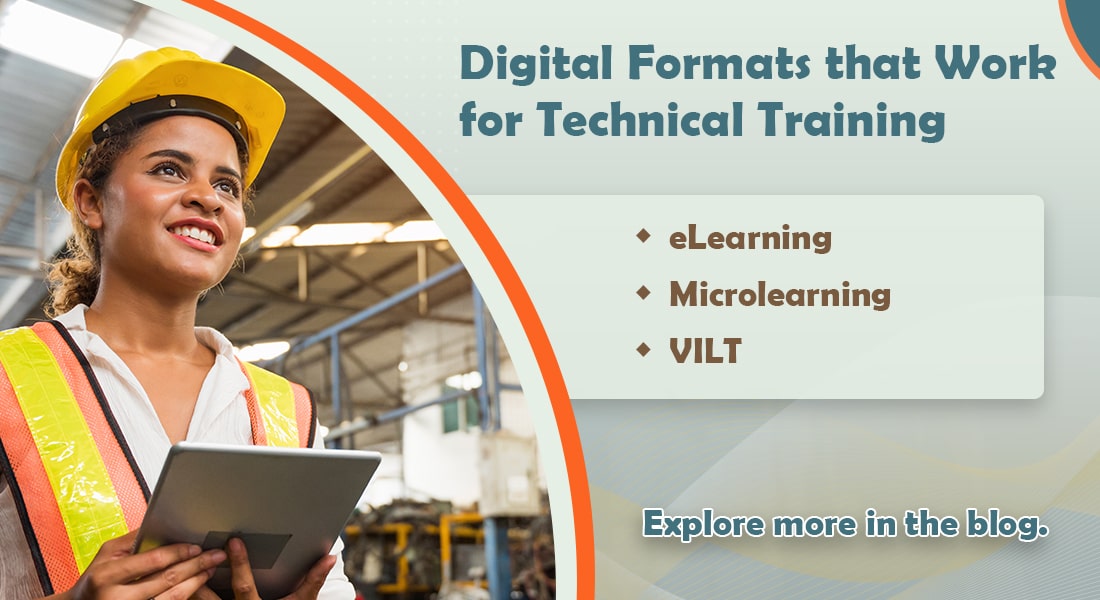A Relook at Technical Training Through the Lens of Digital Learning 2.0

Technical training provides the knowledge and skills required to design, develop, implement, operate, or maintain a technology, product, or service. It usually requires a lot of human interaction, experimental learning, and learning through observation. It also involves tasks that need to be done physically and involves a significant amount of risk. It could involve equipment that can’t always be brought to the classroom. There is very little scope for misinformation and error in technical training. Given these requirements, technical training has become difficult in the current scenario. This blog takes a look at how blended learning can help.
As a training manager, you want to keep up with the latest trends in blended learning to overcome challenges while converting technical classroom training to online training. You would also want to channelize the flexibility and effectiveness of blended learning and make the most of all that technology has to offer.
Digitizing Technical Training
When digitizing a highly technical training program, we can’t rely on any one format to ensure adequate knowledge transfer. Industries that require technical training include:
- Manufacturing industry (deals with heavy equipment, assembly lines)
- Laboratories (deal with chemicals and hazardous substances)
- Agricultural industry (deals with chemicals)
There are a lot of decisions to be made when imparting technical training, digitally. It’s necessary and important to involve subject matter experts (SMEs) from the start when building your online training resources. Once we have insights from the SMEs, we can decide on the most appropriate formats to deliver technical training.
Explore 10 cool tips to save your SME’s time.
Let’s look at the different formats of blended learning that meet technical training needs.
Digital Formats for Technical Training
1. Rapid eLearning Courses
Rapid eLearning helps develop courses from existing classroom material quickly and effectively. It follows the fundamental principles of instructional design to make learning efficient. It focuses on performance-based learning objectives, which is crucial for technical training.
Complex concepts can be covered in a curriculum (a series of courses on a particular topic) of eLearning courses whereas light topics can be covered in standalone courses.
Rapid authoring tools expedite the process of creating and updating constantly changing technical training. Technical training is risk-prone and it’s crucial that employees are trained quickly and efficiently – rapid eLearning helps with robust instructional strategies such as simulations and scenarios.
2. Virtual Instructor-led Training (VILT)
The appeal of VILT lies in how both the instructor and learner can sit in the safety and comfort of their homes and still engage actively in the learning process. We can channel the interaction provided in the classroom through VILT sessions.
New software and technologies have made VILT truly interactive and increased the scope for collaboration tenfold. Technical training needs constant supervision and on-going feedback. Some interesting ways trainers can use VILT to aid this include:
- Chat for textual communication
- Whiteboards for illustrations and explanation
- Breakout rooms for discussions and collaboration
VILT also blends seamlessly with other asynchronous formats to meet different technical training needs. Here are a few effective combinations:
- VILT + eLearning – for spaced learning
- VILT + Mobile Learning – for social learning
- VILT + Microlearning – for performance support
3. Microlearning
Microlearning focuses on one performance-based learning objective, and is extremely useful for technical training as complex skills can be built incrementally by providing information in short, easily digestible nuggets. Important points can be reinforced in spaced intervals using microlearning formats.

Microlearning works great with blended learning to enhance the effectiveness of any training. Some specific formats that can be used for technical training include:
- How-to videos on troubleshooting/assembling
- Quizzes/games on safety precautions
- Infographics highlighting dos and don’ts
- PDFs and ready reckoners on specifications
Explore the A-Z of microlearning.
4. Interactive Videos
As the subject can be quite complex, text-heavy and image-based eLearning courses might fail to capture the interest of your learners. Using videos is highly recommended for technical training.
Some effective video formats include:
- Explainer Videos: to explain highly technical concepts in a simple language.
- Demonstration Videos: to demonstrate tasks that need to be done on-the-job.
- 360-degree Videos: Shot using an omnidirectional camera, to provide a complete view of the scene/object. This is extremely useful in technical training as the physical environment can be replicated digitally.
5. Social Learning
According to the Workplace Learning Report 2021 by LinkedIn Learning, learners who used social features watched approximately 30 more hours of learning content than learners who didn’t. Technical training relies heavily on learning through observation and getting better by collaborating with peers.
Some great features to facilitate social learning in technical training include:
Social Channels – You can create groups in your social media channels for informal discussions and to help learners collaborate with each other and experts.
Online Games and Competitions – These can motivate learners to perform their best as they are motivated by rewards, recognition, and challenges. Use the LMS to reward top performers.
Online Discussion Forums – Discussion forums allow the formal exchange of ideas and peer-based learning.
User-generated Content (UGC) – Training managers can ask SMEs, top performers, and experts to share tips, tricks, and workarounds, and create a catalog of solutions to technical glitches that others can learn from. And video is the simplest way to share user-generated content.
Parting Thoughts
We have looked at the various blended learning formats that aid and enhance online technical corporate training. Go ahead and utilize the potential of blended learning to fortify your training. This coming year, stay on top of the game and convert classroom-intensive training programs also online.
Join this webinar to know the what, the why, and the how!





